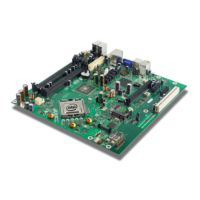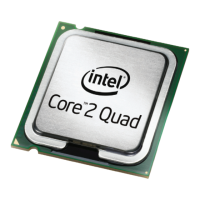Errata
46 Intel
®
Core™2 Extreme Processor X6800 and
Intel
®
Core™2 Duo Desktop Processor E6000 and E4000 Sequence
Specification Update
AI65. A Thermal Interrupt is Not Generated when the Current Temperature
is Invalid
Problem: When the DTS (Digital Thermal Sensor) crosses one of its programmed
thresholds it generates an interrupt and logs the event
(IA32_THERM_STATUS MSR (019Ch) bits [9,7]). Due to this erratum, if the
DTS reaches an invalid temperature (as indicated IA32_THERM_STATUS MSR
bit[31]) it does not generate an interrupt even if one of the programmed
thresholds is crossed and the corresponding log bits become set.
Implication: When the temperature reaches an invalid temperature the CPU does not
generate a Thermal interrupt even if a programmed threshold is crossed.
Workaround: None identified.
Status: For the steppings affected, see the Summary Tables of Changes.
AI66. VMLAUNCH/VMRESUME May Not Fail when VMCS is Programmed to
Cause VM Exit to Return to a Different Mode
Problem: VMLAUNCH/VMRESUME instructions may not fail if the value of the “host
address-space size” VM-exit control differs from the setting of
IA32_EFER.LMA.
Implication: Programming the VMCS to allow the monitor to be in different modes prior to
VMLAUNCH/VMRESUME and after VM-exit may result in undefined behavior
Workaround: Software should ensure that "host address-space size" VM-exit control has
the same value as IA32_EFER.LMA at the time of VMLAUNCH/VMRESUME.
Status: For the steppings affected, see the Summary Tables of Changes.
AI67. IRET under Certain Conditions May Cause an Unexpected Alignment
Check Exception
Problem: In IA-32e mode, it is possible to get an Alignment Check Exception (#AC) on
the IRET instruction even though alignment checks were disabled at the start
of the IRET. This can only occur if the IRET instruction is returning from CPL3
code to CPL3 code. IRETs from CPL0/1/2 are not affected. This erratum can
occur if the EFLAGS value on the stack has the AC flag set, and the interrupt
handler's stack is misaligned. In IA-32e mode, RSP is aligned to a 16-byte
boundary before pushing the stack frame.
Implication: In IA-32e mode, under the conditions given above, an IRET can get a #AC
even if alignment checks are disabled at the start of the IRET. This erratum
can only be observed with a software generated stack frame.
Workaround: Workaround: Software should not generate misaligned stack frames for use
with IRET.
Status: For the steppings affected, see the Summary Tables of Changes.

